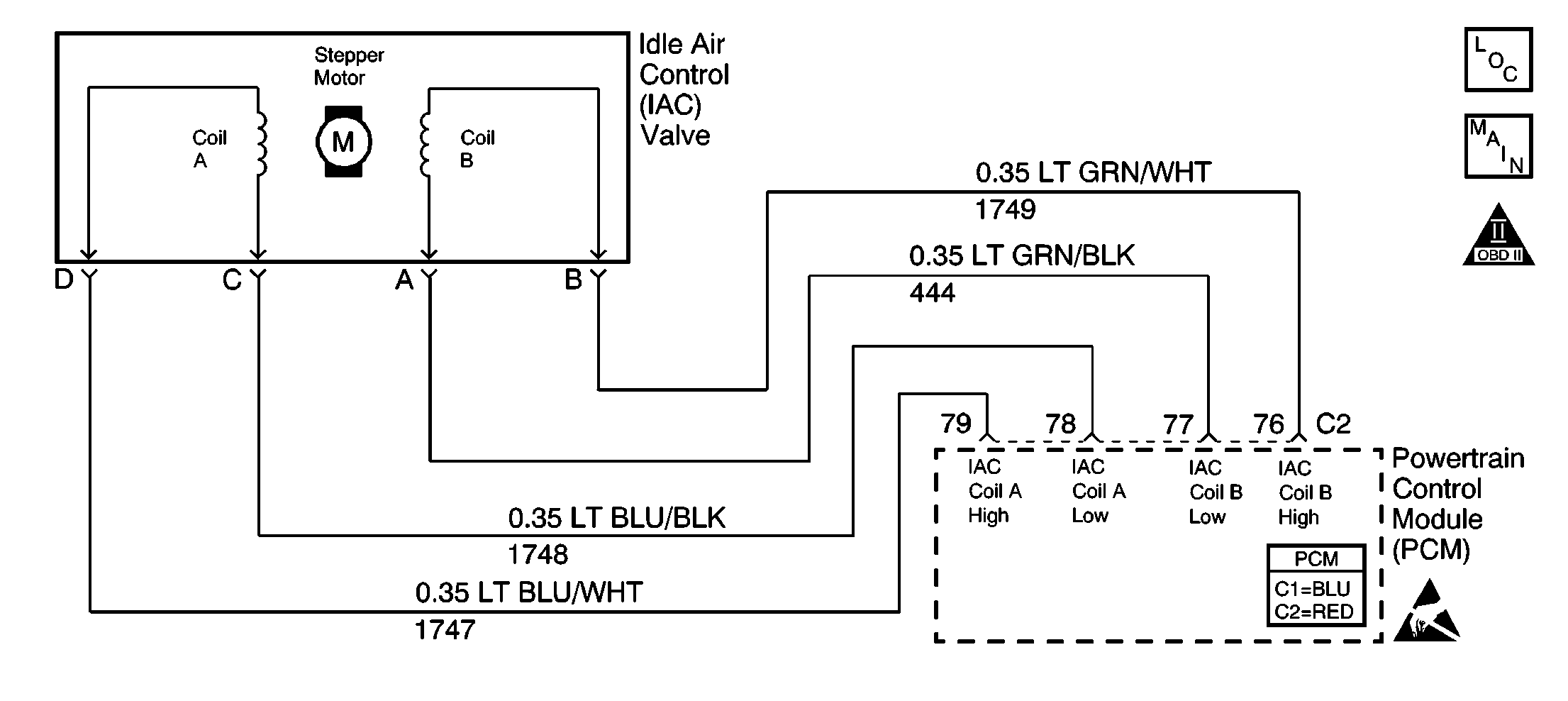
Circuit Description
The Idle Air Control valve is a PCM controlled stepper motor located on the throttle body. The stepper motor drives a valve pintle which protrudes into a passage that bypasses the throttle plates. The PCM commands the IAC valve pintle to extend to decrease the idle speed. The bypass air flow is reduced and the idle speed decreases as the pintle approaches its seat. The PCM retracts the IAC valve pintle away from its seat to increase the idle speed. The retracting of the IAC valve pintle allows more air to bypass the throttle plates. The PCM uses the IAC system to maintain a desired idle speed. This DTC sets when the PCM detects an engine speed outside of the IAC's range of control.
Conditions for Running the DTC
| • | DTCs P0101, P0102, P0103, P0107, P0108, P0112, P0113, P0117, P0118, P0121, P0122, P0123, P0125, P0171, P0172, P0174, P0175, P0220, P0300, P0401, P0404, P0405, P0443, P0500-P0503, P1414 and P1441 are not set. |
| • | The engine run time is more than 60 seconds. |
| • | The engine coolant temperature is more than 60°C (140°F). |
| • | The intake air temperature is more than -10°C (14°F). |
| • | The barometric pressure is more than 65 kPa. |
| • | The ignition voltage is between 9.0 and 17.0 volts |
| • | The vehicle speed is no more than 1 mph (1.6 km/h). |
| • | The throttle position is less than 1 percent. |
Conditions for Setting the DTC
| • | The actual idle speed is 100 RPM less than the desired idle speed. |
| • | All of the above conditions are present for 5 seconds. |
Action Taken When the DTC Sets
| • | The PCM illuminates the malfunction indicator lamp (MIL) on the second consecutive ignition cycle that the diagnostic runs and fails. |
| • | The PCM records the operating conditions at the time the diagnostic fails. The first time the diagnostic fails, the PCM stores this information in the Failure Records. If the diagnostic reports a failure on the second consecutive ignition cycle, the PCM records the operating conditions at the time of the failure. The PCM writes the conditions to the Freeze Frame and updates the Failure Records. |
Conditions for Clearing the MIL/DTC
| • | The PCM turns OFF the malfunction indicator lamp (MIL) after 3 consecutive ignition cycles that the diagnostic runs and does not fail. |
| • | A last test failed, or current DTC, clears when the diagnostic runs and does not fail. |
| • | A history DTC clears after 40 consecutive warm-up cycles, if no failures are reported by this or any other emission related diagnostic. |
| • | Use a scan tool in order to clear the MIL and the DTC. |
Diagnostic Aids
Important:
• Remove any debris from the PCM connector surfaces before servicing
the PCM. Inspect the PCM connector gaskets when diagnosing/replacing the PCM.
Ensure that the gaskets are installed correctly. The gaskets prevent
water intrusion into the PCM. • For any test that requires probing the PCM or a component
harness connector, use the J 35616
connector test adapter kit. Using this kit prevents damage to
the harness/component terminals. Refer to
Using Connector Test Adapters
in Wiring Systems.
For an intermittent, refer to Symptoms .
Test Description
The numbers below refer to the step numbers on the diagnostic table.
Step | Action | Value(s) | Yes | No | ||||||||
|---|---|---|---|---|---|---|---|---|---|---|---|---|
1 | Did you perform the Powertrain On-Board Diagnostic (OBD) System Check? | -- | ||||||||||
|
Important: If any MAF/MAP sensor DTCs are set go to appropriate diagnostic table.
Does the engine speed correspond, within 100 RPM, with each command? | -- | Go to Diagnostic Aids | ||||||||||
3 | Is the engine RPM more than 100 RPM above desired RPM? | -- | ||||||||||
4 |
Did you find and correct the condition? | -- | ||||||||||
5 |
Did you find and correct the condition? | -- | ||||||||||
6 |
Do both of the LEDs on the node light cycle red and green, but never OFF? | -- | ||||||||||
7 |
Important:: During the following test it is possible to overextend the IAC valve pintle until it falls out of the worm drive. If this occurs, manually screw the pintle shaft into the worm drive about 2 turns to get it started, align the keyways on the shaft with the keys in the housing and gradually retract the pintle using the IAC driver tool.
Does the pintle move steadily with each flash of the IAC driver light? | -- | ||||||||||
8 |
Did you find and correct the condition? | -- | ||||||||||
9 |
Is the action complete? | -- | -- | |||||||||
10 | Replace the IAC valve. Refer to Idle Air Control Valve Replacement Is the action complete? | -- | -- | |||||||||
11 |
Did you find and correct the condition? | -- | ||||||||||
12 |
Important:: Program the replacement PCM. Refer to Powertrain Control Module Replacement/Programming . Replace the PCM. Is the action complete? | -- | -- | |||||||||
13 |
Does the scan tool indicate that this test ran and passed? | -- | ||||||||||
14 | Select the Capture Info option and the Review Info option using the scan tool. Does the scan tool display any DTCs that you have not diagnosed? | -- | Go to the applicable DTC table | System OK |
